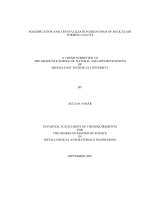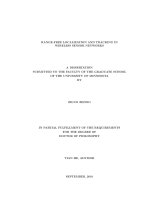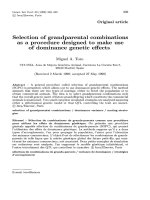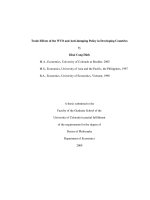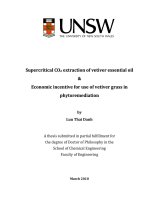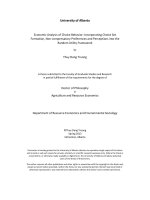a thesis submitted to the faculty of the graduate school of the university of colorado in partial fulfillment of the requirements for the degree of doctor of philosophy department of economics
Bạn đang xem bản rút gọn của tài liệu. Xem và tải ngay bản đầy đủ của tài liệu tại đây (541.68 KB, 130 trang )
Trade Effects of the WTO and Anti-dumping Policy in Developing Countries
by
Khai Cong Dinh
M.A., Economics, University of Colorado at Boulder, 2005
M.S., Economics, University of Asia and the Pacific, the Philippines, 1997
B.A., Economics, University of Economics, Vietnam, 1990
A thesis submitted to the
Faculty of the Graduate School of the
University of Colorado in partial fulfillment
of the requirements for the degree of
Doctor of Philosophy
Department of Economics
2009
This thesis entitled:
Trade Effects of the WTO and Anti-dumping Policy in Developing Countries
By Khai Cong Dinh
has been approved for the Department of Economics
_____________________________________________
Professor Wolfgang Keller, Chair
_____________________________________________
Professor Keith Maskus
Date: _________________________
The final copy of this thesis has been examined by the signatories, and we find that both
the content and the form meet acceptable presentation standards of scholarly work in the
above mentioned discipline.
iii
Dinh, Khai Cong (Ph. D., Economics)
Trade Effects of the WTO and Anti-dumping Policy in Developing Countries
Thesis directed by Prof. Wolfgang Keller and Prof. Keith Maskus
The first chapter of this dissertation is devoted to extensively review literature on
the impact of trade liberalization under GATT/WTO on international trade in developed
and developing countries. It suggests that although it is more likely to see the positive
effect of the GATT/WTO on international trade in developed countries than to do the
same in developing countries, the trade-promoting role of the GATT/WTO is expected to
be found in developing WTO members, at least in some sectors.
Chapter 2 develops a model to test the hypothesis of whether or not the WTO has
promoted international trade in developing WTO members. The contribution of this
chapter into the existing economic literature is that this study investigates the effect of
GATT/WTO membership on international trade in different types of goods, differentiated
and homogeneous, in developing country members. I find that WTO membership has
associated with expanded imports of products which are of primary export interest to
developing countries. I also find that joining the GATT/WTO in a period had a bigger
impact on imports of different types of goods in developing countries than already being
in the GATT/WTO since applicants are required to make more serious commitments on
tariff liberalization and market access before they get approved to accede to the WTO
than the existing developing country members.
Chapter 3 uses a cross-country sample of newly available disaggregated data to
empirically examine trade effects of anti-dumping (AD) cases initiated between 1995 and
iv
2003 in “new AD user” developing countries. I find that there is very limited trade
diversion caused by AD petitions in developing countries due to a reason unique to these
countries; that is, while AD activities in developing countries reduce imports from named
countries relatively high tariff barriers and quantitative restrictions in these countries
impede imports from non-named countries. This is probably the most relevant reason to
explain the outbreak of AD laws and their escalating use in developing countries.
Dedication
To my parents, parents-in-law, wife, and sons
vi
Acknowledgements
I would like to acknowledge the Vietnamese Ministry of Education and Training
and many individuals who gave me special supports and encouragement to complete my
dissertation.
I would like to express my deep gratitude to my advisors, Professor Wolfgang
Keller and Professor Keith Maskus, who gave me valuable comments and suggestions on
my dissertation. I owe special thanks to Professor Maskus who spent his precious time to
shape the framework of my projects and encouraged me to pursue further goals in my
academic career. I am also indebted to Professor Hale Utar for her discussions and
comments on my dissertation, especially chapter 3.
Thanks also go to Nam Hoang, Duong Nguyen, Ha Nguyen, Hang Nguyen, David
Pinto, and Said Boakye for their encouragement and friendship.
All the achievements I have obtained today are dedicated to my parents who have
always believed in my abilities and have always been by my side to give me wonderful
support and encouragement, to my parents-in-law who have always been a great help,
and to my wife and sons whose love has given me strength and confidence to pursue
higher goals in my life.
vii
Contents
Chapter
1. The Impact of the World Trade Organization on International Trade
1
1.1
Introduction………………………………………………………
1
1.2
The Gravity Equation: Some Theoretical Foundations………….
3
1.3
Tariff Liberalization in Developed and Developing Countries….
16
1.4
Effects of Tariff Liberalization on International Trade………….
19
1.5
Effects of the GATT/WTO on International Trade………………
36
1.6
Summary and Suggestions for Future Research…………………
41
2. Do Developing Countries Enjoy Their Membership in the WTO?
43
2.1
Introduction ……………………………………………………...
43
2.2
The Estimation Model…………………………………………….
49
2.3
Data………………………………………………………………..
52
2.4
Econometric Results and Discussion on Empirical Findings…….
53
2.4.1 Basic Results……………………………………………….
53
2.4.2 Do Newly-Joined Developing Country Members Benefit
from the WTO?.................................................................
2.5
58
Conclusion………………………………………………………...
62
3. Trade Effects of Antidumping Policy in Developing Countries………….
64
3.1
Introduction………………………………………………………..
3.2
The Proliferation of AD Policy and AD Activities in
64
Developing Countries……………………………………………… 71
viii
3.3
Literature Review on Trade Destruction and Trade Diversion
of AD Policy………………………………………………………
73
3.3.1
Trade Destruction Effects of AD Actions…………….
73
3.3.2
Empirical Studies on Trade Diversion of AD Policy…
75
3.4
Estimation Model and Estimation Strategy……………………….
83
3.5
Data………………………………………………………………..
85
3.6
Econometric Results and Discussion of Empirical Findings……..
86
3.6.1
Benchmark Results….………………………………… 86
3.6.2
Trade Diversion Effects of AD Cases in the Major
AD Filing Sectors in Developing Countries…………… 87
3.6.3
3.7
Discussion on the Empirical Findings………………… 92
Conclusion and Policy Implications………………………………. 110
Bibliography
113
Appendix A
120
ix
Tables
Table
2.1
Shares of commodity categories across trading groups………
2.2
Shares of commodity categories in value of total trade of
47
each trading group…………………………………………….
48
2.3
Core Regression, Panel 1965-2000……………………………
55
2.4
Cross-section Results………………………………………….
56
2.5
Effects of the GATT/WTO on imports of different goods
in newly-joined and old developing WTO members………….
3.1
Antidumping initiation between 1994/95 and 2002/03
(July/June) by reporting countries…………………………….
3.2
69
Country-wise break-up of AD one-country one-product cases,
1995-2003……………………………………………………..
3.4
65
Sectors most frequently involved in AD cases between 1995
and 2003……………………………………………………….
3.3
60
70
Impact of AD Actions on Values of Imports in the Six
Developing Countries…………………………………………. 88
3.5
Impact of AD Actions on Quantity of Imports in the
Six Developing Countries……………………………………… 89
3.6
Impact of AD Actions on Unit Value of Imports in
the Six Developing Countries…………………………………. 90
x
3.7
Impact of AD Actions on Values of Imports in Major
AD Filing Sectors in the Six Developing Countries…………... 93
3.8
Impact of AD Actions on Quantity of Imports in Major
AD Filing Sectors in the Six Developing Countries…………… 95
3.9
Impact of AD Actions on Unit Value of Imports in Major
AD Filing Sectors in the Six Developing Countries…..………. 97
3.10
Unweighted Average MNF Applied Tariff Rates (6-digit HS).. 99
3.11
Impact of AD Actions on Values of Imports in Turkey
and the Other Developing Countries………………………….. 104
3.12
Impact of AD Actions on Quantity of Imports in Turkey and
the Other Developing Countries……………………………… 106
1
Chapter 1
The Impact of the World Trade Organization on International Trade
1.1
Introduction
Most observers strongly believe that the World Trade Organization (WTO) and its
predecessor, the General Agreement on Tariffs and Trade (GATT), play an important role
in promoting the world trading system. It is stated that under administration of the
GATT/WTO since 1948 world trade has been growing fast. Merchandise exports grew by
6 percent annually. Total trade in 1997 was 14-times the level of 19501. Since 1965 world
trade has grown faster than world income. Therefore, it is expected the GATT/WTO has
helped to create a favorable trading system to foster bilateral and multilateral trade in the
world.
However, Rose (2004) shows that GATT/WTO members do not have
significantly different patterns of trade than non-members; the GATT/WTO has not
systematically played a strong role in encouraging trade. It is really a surprising finding
since tariff barriers in developed and developing WTO members have been removed
substantially through GATT/WTO multilateral and bilateral trade negotiation rounds. For
instance, thanks to the GATT/WTO’s efforts unweighted average applied tariff rates in
developed countries have fallen from high double-digit levels to 6.3 percent in 1995 and
around 3.5 percent in 2005. For developing countries, they were 16.6 percent in 1995
1
Taken from />
2
and 10.6 percent in 20052. Developed countries increased the number of imports whose
tariff rates were “bound” from 78 percent of product lines to 99 percent after the Uruguay
Round while the increase in developing countries was from 21 percent to 73 percent3.
These substantial tariff reductions under GATT/WTO are expected to stimulate
international trade in both developed and developing WTO members.
There are many empirical studies which find the positive effect of tariff
liberalization on international trade in developed countries. For instance, Prewo (1978)
empirically examines the effect of tariff reductions on aggregate bilateral trade flows
among eighteen OECD countries for the years 1958 to 1974 and finds that tariff
reductions promoted trade among these countries. Rose (1991) also finds the positive
effect of tariff reductions on the growth of the trade ratio in twelve OECD economies
from 1951 to 1985. Baier and Bergstrand (2001) show that approximately 25 percent of
the mean growth of trade in eighteen OECD countries could be explained by tariff-rate
reductions. In contrast, there are few empirical studies on the effect of tariff liberalization
on international trade in developing countries due to unavailability of tariff data.
Therefore, Subramanian and Wei (2007) use a gravity estimation model with appropriate
dummy variables to measure the effect of the GATT/WTO on international trade in both
developed and developing countries. Their empirical findings show that while the
GATT/WTO has significantly promoted trade in developed countries its trade-promoting
role in developing countries has been very limited.
The above analysis indicates that little is known about trade effects of the
GATT/WTO in developing countries. Therefore, a further investigation on the hypothesis
2
Source: Trends in Average Applied Tariff Rates in Developing and Industrial Countries, 1981-2006 in
World Bank Database (2006)
3
Taken from />
3
of whether or not the GATT/WTO has promoted international trade in developing
countries would be interesting. This chapter is devoted to extensively review literature on
the effect of trade liberalization under GATT/WTO on international trade to show that it
is rational to expect significant effects of the GATT/WTO on international trade in
developing WTO members. It is aimed at making some suggestions for further research
to better understand trade effects of the GATT/WTO in these countries.
Since most of empirical studies on effects of the GATT/WTO on international
trade in economic literature use a gravity estimation model, therefore, the second section
in this chapter is devoted to discuss some theoretical foundations of the gravity equation.
The third section presents outstanding achievements of the GATT/WTO in tariff
liberalization. The fourth section reviews some literature about effects of tariff reductions
on international trade. The fifth section discusses effects of the GATT/WTO on the world
trading system. The last section summarizes the chapter and makes some suggestions for
further study.
1.2
The Gravity Equation: Some Theoretical Foundations
The gravity equation has been long considered as a very successful empirical
model to explain trade flows between two countries, or two regions. Basically, in this
model trade flows from country i to country j can be explained by income in each
country, economic distance between i and j, and other economic forces that either support
or impede the flows between two countries. The gravity equation is generally specified as
M ij = β 0Yi β1 Y jβ 2 Dijβ 3 Aijβ 4 uij
(1.1)
4
where Mij is the dollar flow of goods from country or region i to country or region j, Yi
and Yj are incomes in i and j, Dij is the economic distance between countries (regions) i
and j, Aij is any other factor either supporting or impeding trade between i and j, and uij is
a log-normally distributed error term with E(ln uij)= 0. This specification was first used in
Timbergen (1962), Poyhonen (1963), however, they only gave intuitive justification for it
(Deardroff, 1998). Therefore, although considered as the successful model in empirical
studies on bilateral trade flows, it was said that an estimated gravity equation did not have
a theoretical foundation.
The first attempt to derive the gravity equation from economic theory was made
by Anderson (1979). In this paper, he first assumes: Cobb-Douglas (and then CES
preferences in an appendix) homothetic preferences identical across countries, perfect
product specification under the assumption that each country produces only one
specialized good, perfect competition, and the same prices in all countries. Using an
expenditure system under constraint given by the importing country’s income and the
exporting country’s income, he derives a restricted gravity equation in which the trade
flow from i to j is a function of only each country’s income with unit income elasticities.
To make the gravity equation more sensible, he assumes that all countries produce a
traded and a nontraded good. Preferences for traded goods are identical across countries
and homothetic, with the traded-goods share now being a function of income and
population. A full set of national tariffs in each country and transport costs proxied by
distance are also incorporated in the model. The gravity equation derived under the above
assumptions is an unrestricted (non-unit income elasticity) one which shows that after
controlling for size, the trade flow from country i to country j depends on their bilateral
5
trade barrier relative to an income-weighted average of barriers between country i and all
the trading partners. Obviously, the average trade cost term will be missing in Eq. (1.1) if
the gravity equation is not derived from economic theories. This implies both that without
the average trade cost term an estimation of Eq. (1.1) suffers from omitted variables
biased and that comparative statics analysis is unfounded (Anderson and Wincoop,
2003).
Different from Anderson (1979), Bergstrand (1985) shows that a gravity equation
similar to Eq. (1.1) can be generated from a general equilibrium (GE) framework with
necessary assumptions. He uses CES preferences over Armington-differentiated goods as
in Anderson (1979). However, the difference is that he allows the elasticity of
substitution between domestic and importable goods and among importables to differ.
The reason is that there exist costs of distribution and marketing to tailor each country’s
product to each national market. These costs are captured by a constant-elasticity-oftransformation that allows each country’s producer to treat export supplies to each market
as imperfect substitutes. A GE model of world trade is derived from utility- and profitmaximizing agent behavior in N countries assuming a single factor of production in each
country. The derived model shows that the trade flow from i to j is a function of all
countries’ resource availabilities for a given year as well as trade barriers and transportcost factors among all pairs of countries. However, that specification is not a gravity
equation since it does not include exporter and importer incomes as in Eq. (1.1). To
derive a gravity equation which includes incomes as exogenous variables from the
system, he first assumes that the market for the aggregate trade flow from i to j is small
relative to other markets. This small market assumption allows exporter income (Yi),
6
importer income (Yj), and certain price terms to be treated as exogenous. The second
assumption is identical utility and production functions across countries, which ensures
all parameters in trade flow and price equations to be constant across all country pairings.
From those two assumptions he derives the “generalized” gravity equation for bilateral
trade in which the trade flow from country i to j is a function of exporter and importer
incomes treated as exogenous, bilateral trade barriers, transport-cost factors among all
pairs of countries, and some price indices. Price indices in Bergstrand’s (1985) gravity
equation are absent in Eq. (1.1). This shows that a gravity equation if not derived from
economic theory may exclude some important variables.
To test the assumption of product differentiation the author estimates the system
by using dummy variables indicating the presence of preferential trading agreements to
proxy for the tariff variable, the distance between economic centers of i and j and a
dummy for adjacency to proxy for the transport-cost factor, and GDP deflators to
approximate the price indices. His empirical estimates support the assumption that goods
are not perfect substitutes and that imports are closer substitutes for each other than for
domestic goods.
In an attempt to derive a gravity equation that is consistent with modern trade
theories, Bergstrand (1989) develops a general equilibrium model of world trade with
two differentiated-product industries and two factors (capital and labor) to see how the
gravity equation, including exporter and importer populations and incomes, fits in the
Heckscher-Ohlin (H-O) model of inter-industry trade and the Helpman-Krugman (1985)
and Markusen (1986) models of intra-industry trade. To derive the demand equation he
first solves for the consumer’s maximization problem using a “nested” Cobb-Douglas-
7
CES-Stone-Gary utility function subject to an income constraint. The derived market
demand curve relates bilateral trade flows and national income, per capita income, and
prices. Countries with similar per capita incomes will have similar demands, as suggested
in Linder (1961). To derive the supply equation he assumes that each firm in each of the
two industries produces a uniquely differentiated product in a market that can be
characterized as Chamberlinian monopolistic competition. That means product
differentiation among firms rather among countries as in Anderson (1979). He assumes
further that each monopolistic competitive sector has different factor proportion, which is
a combination of the perfectly competitive H-O model and the one-sector
monopolistically competitive model of Krugman (1979). Each firm distributes its product
to domestic and foreign markets under diminishing returns, similar to Krugman (1987).
Using the market clearing condition, he derives the gravity equation which shows that the
value of the trade flow from i to j can be explained by exporter i’s income and capitallabor ratio, importer j’s income and per capita income, trade barriers, transport-cost
factor, exchange rates, and price terms. In the typical estimated gravity equation, exporter
GDP is a proxy of i’s national output expressed in terms of units of capital. Exporter
GDP per capita is a proxy of i’s capital-labor endowment ratio. Importer GDP is j’s
national output. Importer GDP per capita is j’s per capita income. Distance is interpreted
as the c.i.f./f.o.b. factor. Hence, Aij in Eq. (1.1) should include measures of j’s tariff rate
on i’s exports, the bilateral exchange rate, and the two complex price terms. His empirical
findings show that including importer and exporter incomes and per capita income in the
gravity model is consistent with modern trade theories of inter-industry and intra-industry
trade.
8
It is easy to recognize that none of the gravity models above are directly derived
from the Heckscher-Ohlin (H-O) model. Therefore, it used to be claimed that the H-O
model is incapable of providing a theoretical foundation for a gravity equation. However,
Deardorff (1998) proves that a gravity equation can be derived from two cases of the H-O
theory. The first is frictionless trade. In this case, since all impediments to trade in
homogeneous goods are absent therefore producers and consumers are indifferent among
trading partners. As a result, patterns of bilateral trade are not determined. Deardorff
resolves this indeterminacy by random drawing in which producers in each industry put
their output into a world pool for their industry; then consumers choose randomly their
desired levels of consumption from these pools. If consumers draw from these pools in
small increments, then the law of large numbers will allow us to predict quite accurately
what their total choices are by using expected values. The expected trade flows will
correspond exactly to the simple frictionless gravity equation whenever preferences are
identical and homothetic. Generalizing the result to arbitrary preferences, he finds that
this gravity equation still holds on average, but that individual trade flows will exceed or
fall short of it depending on a weighted correlation between the exporter’s and the
importer’s deviations from the world average supplies and demands. This in turn is
suggestive of how particular non-homotheticity in demand can interact with factor
endowments and factor proportions to cause countries to trade excessively with countries
like themselves.
The second case is impeded trade in which the author assumes that each country
produces and exports different goods. Different from Anderson (1979) and Bergstrand
(1985) he motivates the differentiation among products by the H-O model’s case of non-
9
FPE and specialization rather than by the Armington assumption. However, this is also a
possible equilibrium of the H-O model. Then he derives expressions for bilateral trade,
first with Cobb-Douglas preferences and then with CES preferences for all goods. The
former yields the simple frictionless gravity equation exactly for trade valued c.i.f. with
no role for trade costs or distance and the standard gravity equation with division by a
transport factor for trade valued f.o.b. The latter generates the gravity equation for trade
valued f.o.b. that includes in the right-hand side each country’s economic size and the
bilateral economic distance between i and j relative to the average of all importing
countries’ relative distance from i. This case shows that bilateral trade flows are centered
around the same values found in the Cobb-Douglas case, but they are smaller for
countries that are a greater than average distance apart as measured by transport cost, and
larger for countries that are closer than average.
In general, the gravity equation derived from theoretical foundations in the abovementioned papers shows that after controlling for size trade between countries is
determined by relative trade barriers which are defined as the bilateral barrier between
them relative to average trade barriers that both regions face with all their trading
partners. The more resistance to trade with all others a region is, the more it is pushed to
trade with a given bilateral trade partner. Anderson and Wincoop (2003) refer to this
theoretical appropriate average trade barrier as “multilateral resistance”. In the empirical
gravity literature either the lack of any forms of “multilateral resistance” in the analysis
or including a “remoteness” variable related to distance to all bilateral partners as in Mc
Callum (1995) causes omitted variable bias in estimation. Therefore, Anderson and
Wincoop (2003) emphasize that it is important to develop a method that consistently and
10
efficiently estimates a theoretical gravity equation and use the estimated general
equilibrium gravity model to conduct comparative static exercises of the effect of trade
barriers on trade flows.
Basically, to derive a gravity equation Anderson and Wincoop (2003) use the
CES expenditure system with the following assumptions. The first assumption is that all
goods are differentiated by place of origin. Each region is specialized in the production of
only one good. The supply of each good is fixed. The second assumption is identical,
homothetic preferences, approximated by a CES utility function. The nominal demand
for country i goods by country j consumers satisfying maximization of the utility function
subject to the budget constraint is as follows.
yy t
xij = i w j ij
y Pi Pj
(1−σ )
Pi1−σ = ∑ Pjσ −1θ j tij1−σ ∀i
(1.2)
(1.3)
j
Pj1−σ = ∑ Piσ −1θitij1−σ ∀j
(1.4)
i
where xij is exports from country i to country j, yi and yj are the nominal income of
countries i and j, yw is the world income, tij is the bilateral trade cost factor between i and
j, σ is the elasticity of substitution between all goods, θi and θj are income shares of
country i and j, Pi an Pj are price indices.
The gravity equation derived from the above system tells us that bilateral trade
flows are determined by size of each country, the bilateral trade barriers between i and j
relative to the product of their multilateral resistance indices. Higher multilateral
resistance of country i or j with other trading partners will raise the bilateral trade
11
between i and j. Obviously, for a given bilateral barrier between i and j, higher barriers
between j and its other trading partners will reduce the relative price of goods from i and
raise imports from i. Higher multilateral resistance between i and other trading partners
will lower the demand for i’s goods and therefore its supply price (pi), which raises the
level of trade between i and j.
The key difference between the above theoretical gravity equation and gravity
models used in the empirical literature is the two “multilateral resistance” indices which
are country i’s resistance to trade with all regions and country j’s resistance to trade with
all regions. The “multilateral resistance” variables are now a function of income shares
(θ) and the bilateral trade barrier (tij) which in turn is a function of all bilateral trade
barriers between i and j such as distance, border, language, etc. Therefore, either missing
these price indices in a gravity equation or misusing them causes biased estimation. For
example, the remoteness index used in Mc Callum’s (1995) does not capture any of other
trade barriers that are the focus of the analysis. Even if distance were the only trade
barrier, its functional form in the remoteness index is disconnected from the theory.
Unfortunately, the two “multilateral resistance” indices in Anderson and Wincoop
(2003) are unobservable and these price indices in general can not be interpreted as
consumer price levels. In fact, we can solve for these price indices as an implicit function
of observables using the goods market-equilibrium conditions in Eq. (1.3) and the trade
cost function. Then the right-hand side of Eq. (1.2) can now be written explicitly as a
function of observables and the gravity equation Eq. (1.2) can be estimated with nonlinear least squares. An alternative to estimate Eq. (1.2) is to replace the multilateral
resistance terms with country-specific dummies since they are time-constant
12
unobservable variables and then estimate it using ordinary least squares. This also leads
to consistent estimates of model parameters. However, it is also necessary to note that the
fixed-effects estimator is less efficient than the nonlinear least-squares estimator since the
latter uses information on the full structure of the model.
Helpman and Krugman (1985) also derive a version of the gravity equation. They
assume perfect specialization in production and then identical homothetic preferences.
Under these two assumptions, country i consumes a fraction si of every good that is
produced in the world economy and it exports a fraction (1-si) of every good that it
produces, with a fraction sj of its output being exported to country j. Therefore, bilateral
trade between country i and j is
xij = s j GDP i = s i s j GDP
(1.5)
where xij is exports from country i to country j, si and sj are shares of expenditures in
country i and country j, and GDP is the world income. Obviously, Eq. (1.5) is consistent
with the simple frictionless gravity equation derived from the different models above
because they all share the two basic assumptions: perfect specialization and identical
homothetic preferences. However, there are two differences we should notice. First,
while in Anderson (1979) and Anderson and Wincoop (2003) the assumption of perfect
specialization is the Armington assumption positing that consumers view goods as
differentiated by country of origin, in Deardorff (1998) it is motivated by the H-O
model’s case of non-FPE and specialization, that assumption in Helpman and Krugman
(1985) is derived from market structure, monopolistic competition. The role of
monopolistic competition to insure that all goods are produced in only one country is
explained as follows. Imagine that there is a firm operating in a differentiated product
13
industry in which every variety is produced with increasing returns to scale. Further
assume that these economies of scale are relatively small so that the industry can
accommodate many producers, each one producing a different variety. Then, in that
market structure known as monopolistic competition every firm has to choose a variety
and its pricing so as to maximize profits, taking as given the variety choice and pricing
strategies of other firms in the industry. Assume that every variety of the product is
produced with the same production function and also enters into demand in the same
way. The cost function is assumed to be derived from an increasing-returns-to-scale
technology (see Krugman 1980). The demand function depends on the structure of
preferences. When preferences are of the Spence-Dixit-Stiglitz type, a single producer
competes equally with every other producer, and derives the same profit level for any
variety choice that is not supplied by others. If he were to choose a variety that is already
supplied by another firm, he would have to share the market for this variety, thereby
ending up with profits lower than those he could attain by adopting some other varieties.
Therefore, no variety will be produced by more than one firm/country.
Second, in absence of transportation costs and tariff barriers, the HelpmanKrugman model leads to the simple gravity equation similar to Anderson’s (1979) but the
number of goods produced differs across countries of different economic size, and
depends endogenously upon the level of fixed costs in production, the taste for variety,
and factor endowments (Baier and Bergstrand, 2001).
Obviously, perfect specialization is really an important assumption to derive a
gravity equation. However, Evenett and Keller (2002) interestingly raise a question that
whether the predictions of the perfect specialization in the two important theories of
14
trade, the H-O theory and the IRS theory, are supported by the data and can account for
the empirical success of the so-called gravity equation. They address the identification
problem by noting that in constant returns to scale (CRS) H-O world perfect
specialization results only when bilateral differences in factor proportions are large
enough. In contrast, when product specialization is the result of IRS, the gravity
prediction can be obtained even if there are no differences in factor proportions.
Furthermore, these models predict different types of trade: in the H-O model, trade
occurs exclusively in goods produced with different factor intensities (inter-industry
trade) while in the IRS model, some trade is intra-industry. Consequently, they take
samples with high shares of intra-industry trade in total trade as those in which IRS-based
specialization might drive the gravity equation. And those samples with low shares of
intra-industry trade in total trade and large differences in factor proportions are those in
which a model of H-O-based specialization might be behind the gravity equation.
To develop gravity equation models they assume that there is balanced trade, zero
trade and transportation costs, no trade in intermediate goods, and two countries with
identical production technologies and that consumers in both countries have identical
homothetic preferences. Then they develop four models of gravity equation, two with
perfect specialization (IRS and multicone H-O models) and two with imperfect
specialization (IRS/unicone H-O and unicone H-O models).
To test the four models, first of all, they employ the index proposed by Grubel
and Lloyd (1975) (GL), which measures the share of intra-industry trade in total trade, to
split the bilateral imports observations into two sub-samples according to an arbitrarily
chosen critical level of intra-industry trade, denoted GL*. Those pairs in which GLij ≤
15
GL* belong to what is referred to as the low GL sample, and the remaining observations
are parts of the high GL sample. The samples differ in that they expect substantial
amounts of trade based on product differentiation and IRS in the latter but not in the
former. Given the critical level GL*, it will be useful to sort the data, and form classes. In
the low GL sample they sort data according to each observation’s differences in factor
proportions. On the other hand, they sort the observations in the high GL sample
according to their level of intra-industry trade.
Then they regress the IRS model and the IRS/unicone H-O model in the high GL
sample and the unicone and multicone H-O models in the low GL sample. Econometric
results show that predictions of the perfect specialization versions of both theories are
rejected by the data and so are unlikely explanations for the success of the gravity
equation. Perhaps, this is in part related to the fact that the prediction of trade volume of
both of these models holds only if the production of all goods is perfectly specialized,
which is unlikely. However, the authors find the evidence to support both the
IRS/unicone H-O model and the unicone H-O model in which imperfect specialization is
assumed.
In the next section tariff liberalization under GATT/WTO in developed and
developing countries will be discussed to show that although it is more likely to see the
positive effect of the GATT/WTO on international trade in developed countries due to
the fact that these countries have more actively participated in reciprocal trade
liberalization than developing countries the trade-promoting role of the GATT/WTO in
developing countries is expected to be found, at least in some sectors.

